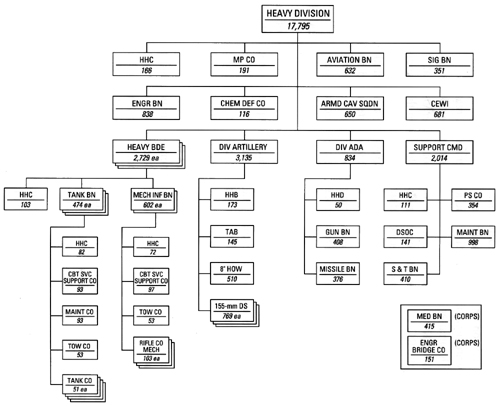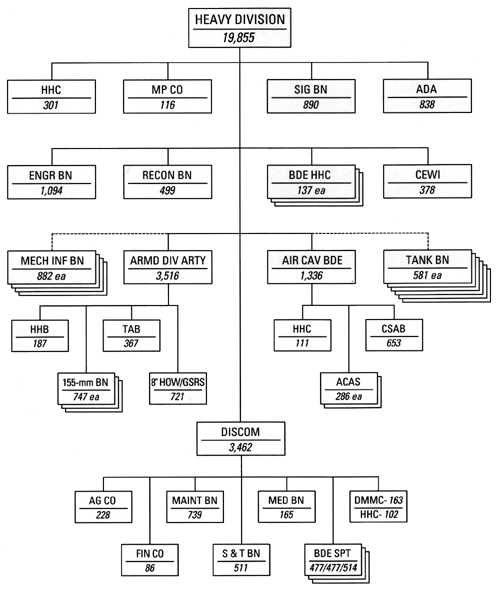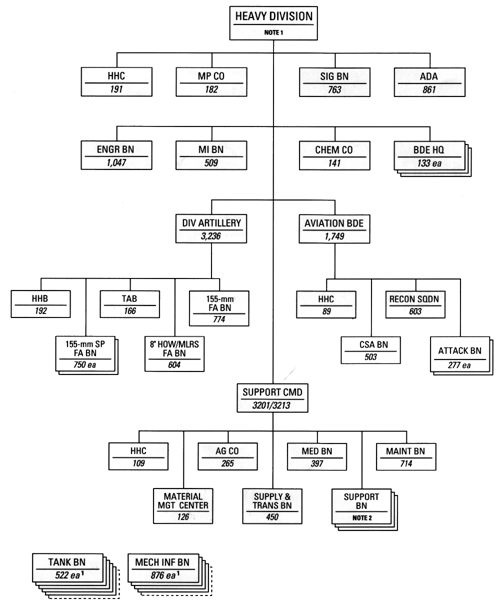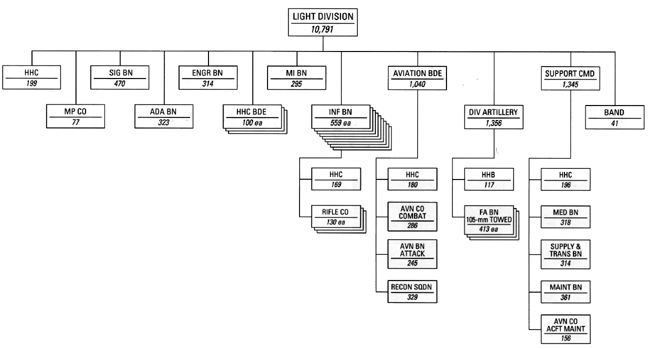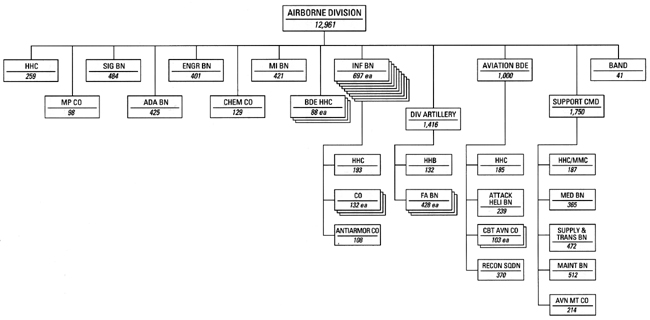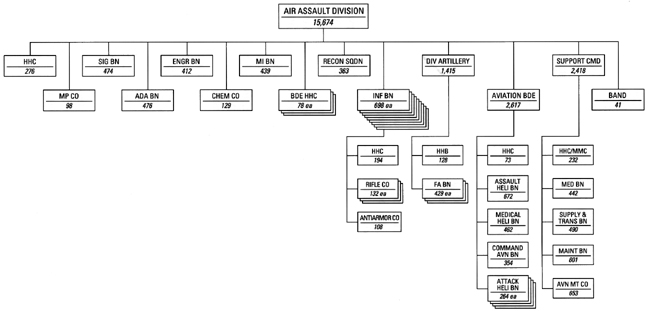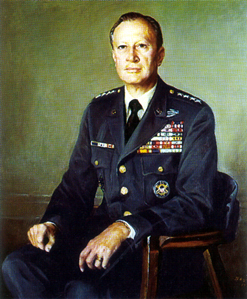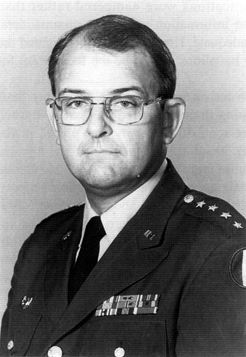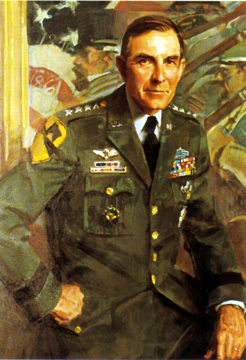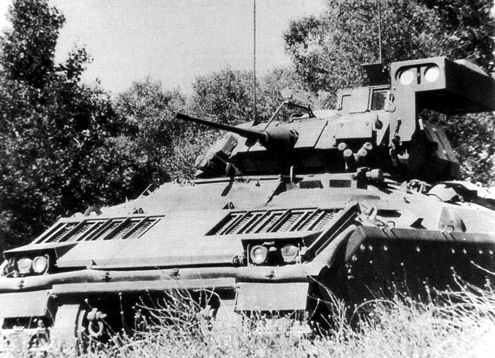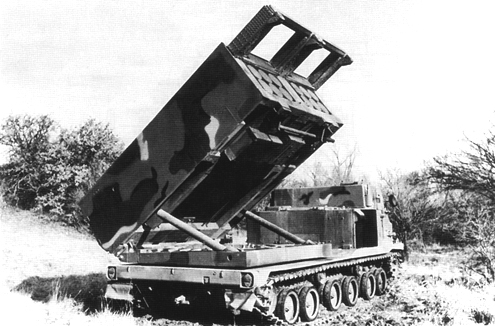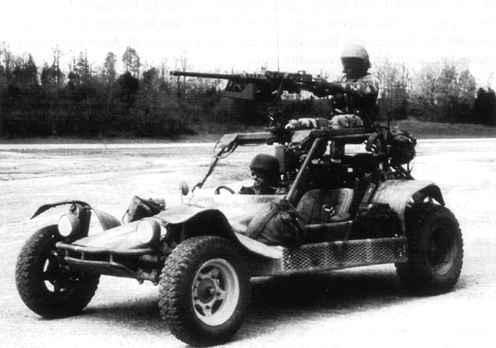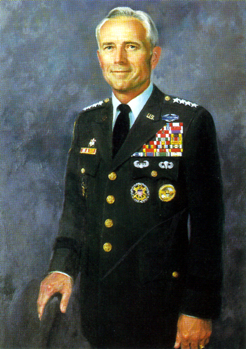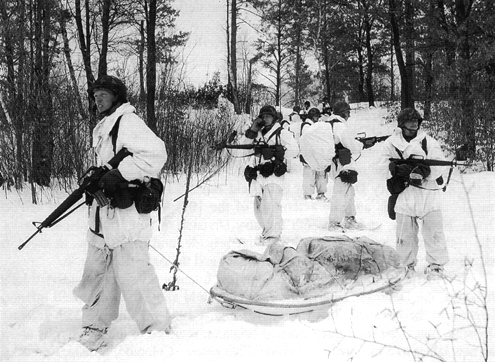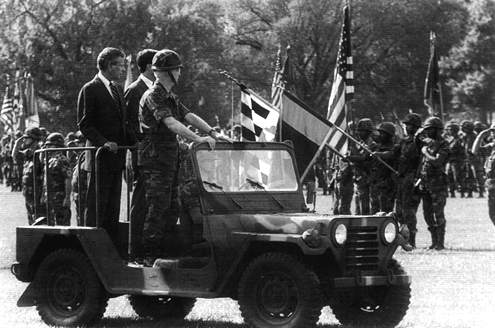-
-
- The lightning war between the Arabs
and Israelis in 1973, when the Egyptian and Syrian armies lost more tanks
than the United States had in Europe at the time, caused the Army to rethink
its doctrine and the structure of its divisions and brigades. An examination
of the seventeen-day conflict led to new ideas about how to prepare for
war and how to fight. Known as the "Active Defense," the new doctrine
stressed defense as the principal mode of combat. Other factors embedded
in the new approach were the speed with which decisive actions would take
place and an awareness of the increased lethality of modern weapons on the
battlefield. Both considerations put added pressure on the Army to improve
the combat capabilities of forward-deployed active forces and the speed
with which effective reserve components units could be delivered to overseas
battlegrounds.2
-
- Since the Army was on the threshold
of adopting new equipment and weapons that increased mobility, firepower,
and maneuver, the Army's schools, commands, and agencies examined such issues
as military intelligence organizations; signal and aviation requirements;
and chemical, biological, and nuclear defense, seeking better ways to maximize
the new technology and not just providing "tag alongs" in existing
organizations. Fire support teams for artillery;
- [379]
- General Weyand
-
- bifunctional staffs (the unit commander
serving as a chief of staff with two deputies, one for operations and military
intelligence and the other for personnel and logistics); rearmament, refueling,
and maintenance in the forward area of the battlefield; and consolidation
of administration at the battalion level also came under scrutiny.3
-
- In March 1975 Chief of Staff General
Fred C. Weyand suggested to Deputy Chief of Staff for Operations and Plans
Lt. Gen. Donald H. Cowles that the structure of divisions should be reexamined.
Weyand was concerned that new technology had resulted in only "add
ons" to divisions, increasing their weight and complexity and decreasing
their overall flexibility. Cowles turned to General William E. DePuy, commander
of the U. S. Army Training and Doctrine Command (TRADOC), established in
1973 specifically to address training and doctrine issues, for his views.
DePuy assembled a group of officers from his command and the Army's schools
and centers to conduct a division restructuring analysis focused on finding
the optimum antiarmor capability for divisions. Among the areas considered
were the employment of the new armored vehicles coming into service and
the problems associated with exploiting new artillery and target acquisition
systems whose range had been greatly increased. 4
-
- The major product of the Division
Restructuring Study (DRS) was the "heavy division" (Chart 44),
an organization designed to replace both mechanized infantry and armored
divisions. Headed by Col. (later General) John Foss, from the Training and
Doctrine Command, the planning group believed that the principles underlying
the new organization could be applied to all divisions.
-
- The heavy division included three
brigades, each consisting of a permanent combat team of two mechanized infantry
and three tank battalions. Infantry battalions consisted of one combat support,
one TOW, and three small rifle companies; tank battalions, similar in structure
to the mechanized infantry units, fielded three tank companies and maintenance,
TOW, and combat support companies. A tank company had three tank platoons
with each platoon having only three tanks. The precise location of the TOW
antitank missile launchers posed the old problem of centralized versus decentralized
control for the planners, much as had the introduction of other new weapons
and equipment, such as the machine gun, tank, antitank gun, airplane, and
helicopter. For now they remained under control of the battalion.5
- [380]
- Heavy Division, Division Restructuring Study 1 March 1977
-
-
- [381]
- To increase firepower, the number
of 155-mm. howitzers in each direct support artillery battery was increased
from six to eight, and the number of firing batteries in a battalion rose
from three to four. The number of batteries in the 8-inch howitzer battalion
was also increased to four. Since the group foresaw a larger divisional combat
area in both width and depth, the artillery's counterfire (destroying enemy
artillery) capabilities moved from the corps level to the division, with a
target acquisition battery added to the division artillery to locate those
targets. A smaller cavalry squadron fielded only three ground troops, with
the air cavalry troop moved to a new divisional aviation battalion. For antiaircraft
defense, the study gave the heavy division an air defense artillery brigade
comprising two battalions, one for the forward area of the battlefield and
another for the rear.6
-
- With smaller divisional infantry
and armor battalions, planners envisioned integrating the combat arms at
the battalion rather than at the company level. Under the ROAD concept a
company team had been the principal combat formation. For example, a mechanized
infantry company was normally reinforced with engineers, forward artillery
observers, and possibly tanks, antitank weapons, and helicopters. But the
company commander who integrated these forces had no staff and probably
lacked the experience to achieve the most effective use of all these resources.
A change of focus therefore appeared necessary.7
-
- Combat support within the new division
also underwent radical changes. A combat electronic warfare intelligence
(CEWI) battalion was organized from military intelligence and Army Security
Agency resources. Consisting of an electronic warfare company and a ground
surveillance company, along with a headquarters and operations company,
the battalion greatly expanded the division's intelligence collection and
analysis capabilities. As noted, the reconnaissance squadron's aviation
troop was moved to a new divisional aviation battalion, which consolidated
the attack helicopter company and the division's command and control aviation
resources in one unit. All mess resources were grouped at battalion level,
and a personnel service company merged finance and personnel services into
one company, which was included in the support command. That command also
fielded a supply and transport battalion, a maintenance battalion, and a
support operations center. A chemical company provided the division with
smoke generating resources and the ability to assist in defense against
biological, nuclear, and chemical weapons. In the past no chemical unit
had existed in a division, and all units had been expected to defend against
those weapons as a primary responsibility. Finally, the study moved the
divisional medical battalion and the bridge company from the engineer battalion
to the corps level.8
-
- A field test of the new structure
at Fort Hood by a brigade of the 1st Cavalry Division in 1979 produced mixed
results. Lt. Gen. Marvin D. Fuller, the III Corps commander, who oversaw
the test, found the division overmanned and overequipped in many areas,
giving commanders resources to cover every possible deficiency or contingency.
He thought the additional costs in personnel and equipment would price the
division out of reach. He also found that radios had
- [382]
- proliferated to the extent that communications
were hampered rather than improved, that bifunctional staffs filtered information
needed by commanders, and that air defense coverage was still inadequate.
However, the test validated the belief that tank and mechanized infantry battalions
should be the focal point for the integration of the combined arms.9
-
- During the evaluation of the division
restructuring concept, the Army Staff approved selective improvements in
existing divisions based on lessons learned from the 1973 Arab-Israeli War.
A target acquisition battery was placed in the division artillery to identify
targets up to 50 kilometers in front of the forward edge of the battle area.
Chemical companies were added to divisions to provide nuclear, biological,
and chemical reconnaissance and decontamination support. Because of the
need to acquire and evaluate information about the enemy, divisional military
intelligence battalions of the CEWI type were organized beginning in 1979.
In the armored and mechanized infantry divisions, aviation resources were
again pooled to form aviation battalions. The airborne division was assigned
three antitank TOW companies, one for each brigade, while the infantry division
in Korea was assigned only a company. When the aerial field artillery battalion
was inactivated in the air assault division, antitank resources were concentrated
in an aviation battalion.10
-
- Along with upgrading existing divisions,
the Department of Defense directed the Army to increase its mechanized forces.
In September 1979 the 24th Infantry Division converted from infantry to
mechanized infantry, and the following year elements were assigned to the
previously unmanned 149th Armored Brigade in the Kentucky Army National
Guard, raising the number of brigades in the total force to twenty-five.
By 1980 the Texas Guard had eliminated its unfilled 36th Airborne Brigade,
using its personnel to organize a corps-level combat engineer battalion.
Planners also considered reorganizing all infantry divisions, except the
airborne and the airmobile forces, as mechanized units.11
-
-
- Before the 1st Cavalry Division
completed its evaluation of the heavy division in 1979, the new commander
of the Training and Doctrine Command, General Donn A. Starry, began to develop
another divisional concept that built upon the Division Restructuring Study.
From his experience as the V Corps commander in Europe, Starry believed
that Foss' Division Restructuring Study group had worked too quickly. Units
had conducted tests without proper training, and the opposing forces lacked
adequate knowledge of Soviet tactics. Therefore, he judged that the test
results could not be totally ascribed to deficiencies in tactics, leadership,
or organization. 12
-
- The Division Restructuring Study
had concentrated on the active defense, the lethality of the battlefield,
and the need to win the first battle, but Starry stressed the offense and
"central battle" where all aspects of firepower and maneuver,
air
- [383]
- General Starry
-
- and ground, would come together
over a wide area to produce a decisive action. He believed that analysis
of those elements in the battle area, including the range of weapons and
their rates of fire, the size of the opposing forces, the terrain over which
they would advance, and the speed of that advance, would permit development
of more effective operational concepts. In addition, he thought consideration
had to be given to "force generation," the task of concentrating
the combat power of the division for the central battle. These ideas evolved
into the "AirLand Battle" doctrine, which was published in 1982
in the revised Field Manual, 100-5, Operations.
13
-
- Analysis of combat within the framework
of the AirLand Battle concept led to the development of "Division-86,"
so named because 1986 was as far out as General Meyer and his advisers could
project the threat. Because of the importance of Europe to national security,
Division-86, like the Division Restructuring Study, emphasized a standardized
heavy division, which combined both armored and mechanized infantry divisions,
and focused on maximizing the new equipment entering the inventory. In October
1979, four months after General Edward C. Meyer became Chief of Staff, Starry
presented his Division-86 proposal, which Meyer approved in principle on
the 18th of that month. His final decision about fielding such a division
depended upon studies to be conducted for light divisions (infantry, airborne,
and airmobile), corps, and echelons above the corps level.14
-
- Division-86, as presented to General
Meyer, retained the flexible ROAD structure. The new heavy division consisted
of a headquarters and headquarters company; three brigade headquarters;
a military police company; signal, air defense artillery, engineer, and
military intelligence battalions; a reconnaissance squadron; division artillery;
an air cavalry attack brigade; a division support command; and a number
of maneuver elements to be determined, possibly four or five mechanized
infantry battalions and five or six armor battalions. The division would
total approximately 20,000 officers and enlisted men (Chart
45).15
-
- Under the "come-as-you-are,
fight-as-you-are" approach to war, combat service support had to be
immediately available in the battle area. To meet the new
- [384]
- Heavy Division (Tank Heavy) As Briefed to General Meyer on 18 October
1979
-
-
- [385]
- General Meyer
-
- logistical requirements, the study
called for a radical reorganization of the division support command, primarily
to address the forward area of the battlefield. The command included a materiel
management center, adjutant general and finance companies, a supply and
transport battalion, a maintenance battalion, and three support battalions,
one for each divisional brigade. Support battalions, which were to "arm,
fuel, fix, and feed forward," included headquarters and headquarters,
supply, maintenance, and medical companies. A small medical battalion supported
the rest of the division. Planners had difficulty deciding whether to place
a chemical company at corps, division, or division support command level,
but gave it to the supply and transport battalion in the support command.16
-
- Evidence of fundamental change existed
within the combat arms. Each tank battalion consisted of a headquarters
element and four tank companies, and each tank company fielded three platoons
of four tanks each. Mechanized infantry battalions contained a headquarters
element along with one TOW and four rifle companies, with the riflemen to
be mounted on new Bradley infantry fighting vehicles. To counter the Soviet
Union's high density of artillery and improved weapons, the Division-86
study, like its predecessor, significantly increased the division artillery.
It fielded three battalions of 155-mm. self-propelled howitzers organized
into three batteries, each having eight pieces; one battalion of sixteen
8-inch howitzers and nine multiple launch rocket systems (MLRS) mounted
on vehicles; and a target acquisition battalion. 17
-
- The reconnaissance squadron called
for three troops, each having two platoons equipped with cavalry fighting
vehicles similar to the Bradley fighting vehicle-and a platoon of motorcycles.
A new organization, an air cavalry attack brigade (later designated as an
aviation brigade), which resulted from the pioneer work of the 1st Cavalry
Division and the 6th Cavalry Brigade at Fort Hood and others, appeared in
the division to provide helicopters for an antitank role. Two attack battalions,
each consisting of four companies with six helicopters each, and a combat
support aviation battalion, which provided resources for command aviation,
aircraft maintenance, and the military intelligence battalion, made up the
brigade. The brigade fielded 134 aircraft.18
- [386]
-
- The Bradley fighting vehicle and, below, multiple launch rocket systems
-
-
- [387]
- Heavy Division, 1 October 1982
-
-
- Note 1 Variation 1-6, 4 mechanized infantry battalions (M113) 18,954.
- Variation 2-5, 5 mechanized infantry battalions (M113) 19,302.
- Variation 3-6, 4 mechanized infantry battalions (BFVS) 19,040.
- Variation 4-5, 5 mechanized infantry battalions (BFVS) 19,407.
- Variation 5-6, 4 mechanized infantry battalions (BFVS) 20,459.
-
- Note 2 Support battalions vary in the number of armor and mechanized
infantry forward support teams: 2 armor and infantry, 377; 2 armor and 2
infantry, 402; and 1 armor and 2 infantry , 363.
-
- [388]
- The distribution of air defense weapons
had haunted the planners. Because of the breadth and depth of the battlefield
one commander could not easily supervise air defense in the division's forward
and rear areas, with each area requiring unique weapons. An air defense artillery
brigade seemed to be one solution, but personnel constraints ruled it out.
Therefore, the division was authorized an air defense artillery battalion
outfitted with a mix of short-range (man-portable Stingers) and mid-range
(Chaparral) missiles, to be supplemented by the still experimental Sergeant
York gun system.19
-
- The Training and Doctrine Command
published tables of organization and equipment for this second try at the
heavy division concept on 1 October 1982 (Chart 46). One set of tables covered
both the mechanized infantry division and the armored division, but with
five variations. Five or six armor and four or five mechanized infantry
battalions were to be assigned to an armored division, and a mechanized
infantry division was to have five armor and five mechanized infantry battalions.
Variations in the tables also covered different equipment, M60 tanks and
M 113 armored personnel carriers or the new M 1 Abrams tanks and Bradley
infantry fighting vehicles. Given the variations, the strength of heavy
divisions ranged between 19,000 and 20,500 officers and enlisted men.20
-
- The published tables differed somewhat
from the proposed heavy division that Meyer had approved three years earlier.
Cavalry fighting vehicles replaced tanks in the reconnaissance squadron,
and the squadron, consisting of two ground and two air troops, had no motorcycles.
Rather than being a divisional unit, it was a part of the aviation brigade.
The finance unit moved to the corps level, and the reorganized military
intelligence battalion fielded electronic warfare, surveillance, and service
companies. In the support command, the medical battalion reappeared, but
the chemical company was returned to divisional level, and the target acquisition
element was reduced to a battery.21
-
- The Army faced complex problems
in fielding Division-86. Over forty major weapons or new pieces of equipment
needed to be procured, and some were still in developmental stages. Doctrinal
literature and training programs required revision, and budgetary limitations
had to be considered. The solution approved by the Army Staff, as in the
past, was to adopt the heavy division concept but with interim organizations
using obsolete equipment until new weapons and equipment were available.
Delivery of many new items was expected to begin in 1983. Therefore, organizational
and equipment modernization was to begin in January of that year. The number
of maneuver elements for a heavy armored division was set at six armor and
four mechanized infantry battalions, while that for a heavy mechanized infantry
division was placed at five armor and five mechanized infantry battalions.22
-
- The Army also faced another problem
in fielding the new heavy division, a shortfall in personnel. The Training
and Doctrine Command estimated that a strength of 836,000 was required to
field Army-86, but only 780,000 was authorized for the foreseeable future.
Therefore to provide manpower spaces for mod-
- [389]
- ernizing the forces in Germany,
the 4th Brigade, 4th Infantry Division, was inactivated in Europe in 1984
along with other units throughout the Army. Shortly thereafter the modernization
plan went awry. Because of various problems involved in funding and procuring
equipment, the Army leadership slipped the completion date for modernizing
heavy divisions to the mid-1990s.23
-
- Early in the planning process for
modernizing divisional forces, Meyer also decided to adopt a new regimental
system. It was to address one aspect of the "hollow Army" (the
problem of having sufficient personnel and equipment to support and sustain
the forward-deployed Army), unit cohesion.24
Patterned after the Combat Arms Regimental System (CARS), the new United
States Army Regimental System assigned each armor, air defense artillery,
cavalry, field artillery, and infantry regiment -later aviation regiments
and special forces 25
were added-a home base from which regimental elements would rotate between
continental and overseas assignments. A soldier could affiliate with a regiment
and expect to serve in it for most of his or her career. By necessity the
new system broke traditional regimental associations with divisions since
fewer regiments could be accommodated in the system because of the linking
of elements between overseas and continental stations. Meyer believed that
the benefits of unit cohesion outweighed the loss of divisional affiliation.
He tied implementation of the new regimental system to modernization of
the force. By 1985 implementation of the regimental system was separated
from force modernization because of production delays, and unit rotation
was abandoned because of personnel turbulence and its adverse effect on
readiness. Nevertheless, designating regiments as part of the system continued,
paced by the number of flags that the US. Army Support Activity, Philadelphia,
could manufacture each month. The flags were needed when the battalion designations
were changed.26
-
-
- In 1979, when Meyer had approved
the heavy division, he also had directed Starry to standardize infantry,
airborne, and airmobile divisions-now called "light divisions."
Meyer, who opposed the total heavy force envisioned by Department of Defense
planners, wanted the Training and Doctrine Command to focus on the infantry
division; airborne and airmobile divisions were to be considered later.
He particularly wanted to know if the infantry division could be designed
to move and fight in contingency areas, such as the Asiatic rim, and still
have sufficient resources to delay and fight Soviet forces in Central Europe.
This question posed the dilemma that had plagued the airborne division community
since World War 11-how to give a unit strategic mobility and still have
it possess the firepower and the resources to sustain itself in combat.
Meyer thought the answer to the problem lay in the use of new technology,
which included advanced radar, intelligence, and satellite resources; containerized
food and equipment; lightweight, high power communications; new lightweight
vehicles; highly accu-
- [390]
- rate and powerful, but lightweight,
weapons; advanced helicopters; and other developments. Two international
events in 1979, the widening of the conflict between the Soviets and the
Afghans and Iran's seizure of American hostages, spurred the need for light,
versatile units.27
-
- An effective structure for the "non-heavy"
infantry division, however, proved elusive. Initially Starry set restrictions
on the division. Its size was not to exceed 14,000 soldiers, it was to be
without organic tank or mechanized infantry units, and it was to be deployable
in Air Force C-141 aircraft. After four tries and a relaxation of the strength
requirement, Starry recommended a division of 17,773 officers and enlisted
men, which Meyer approved for further development and testing on 18 September
1980.28
-
- As planners developed various ideas
for a light division, the Army Staff selected the 9th Infantry Division
at Fort Lewis, Washington, to serve as a "test bed," or a field
laboratory, for equipment, organization, and operations. One objective was
to shorten the equipment developmental cycle typically from five to seven
years-which had frustrated Meyer and others. Although Meyer obviously wanted
the division to experiment with new equipment, difficulties in funding hobbled
the effort from the start. Some of these problems were overcome through
the direct intervention of the Army Staff, but others were never surmounted.
In 1982 Meyer thus changed the emphasis of the 9th Division's mission from
testing highly technical equipment to developing innovative organizational
and operational concepts. The result was the design of a motorized division
of 13,000 men and capable of being airlifted anywhere in the world. Before
the 9th Infantry Division completed its new assignment, however, the Army
set off in a new direction for the light division.29
-
-
- By 1983 planners had reassessed
the nature and direction of world events and the types of conflicts that
could be expected. As Meyer saw a need for a balance between heavy and light
divisions, so did his replacement, Chief of Staff General John A. Wickham.
The successful operations of the British in the Falkland Islands, the Israelis
in Lebanon, and the United States in Grenada all drove home the point that
credible forces did not have to be heavy forces. To have light divisions
within the Army's limited resources, Wickham ordered the replacement of
the 16,000-man standard infantry division with a new light infantry unit
of about 10,000 men and the adaptation of light concepts to airborne and
airmobile divisions. He also wanted the design applied to the motorized
division under development at Fort Lewis. Furthermore, Wickham desired light
divisions to have an improved "tooth-to-tail" (i.e., combat strength
to logistics) ratio and to be deployable three times faster than existing
infantry divisions. With these changes he anticipated that the corps would
be strengthened and made the focus of the AirLand Battle doctrine.30
- [391]
- 9th Infantry Division "dune buggy" used in training
-
- Under Wickham's guidance the Army
specified that corps were to plan and conduct major operations, while divisions
were to concentrate on the tactical battlefield. The revised Field Manual
100-5, Operations, of 1986 defined the corps as the Army's largest
tactical unit. Tailored for a particular theater and mission, the corps
was to contain all combat, combat support, and combat service support required
for sustained operations. In addition to various types of divisions, the
corps was to have available an armored cavalry regiment; field artillery,
air defense artillery, engineer, signal, aviation, and military intelligence
brigades; and a military police group. Infantry and armored brigades and
psychological operations, special operations forces, and civil affairs units
could be attached as needed. When organized for a particular theater and
mission, the corps was thus to be a relatively fixed organization with area
as well as combat responsibilities. The newly defined corps was really a
throwback to the beginning of the century when Field Service Regulations
described a prototype corps.31
-
- Wickham's guidance resulted in the
development of units for the "Army of Excellence." 32
Within that rubric, the tables of organization and equipment called for
a 10,220-man light infantry division, which comprised a headquarters and
headquarters company; a military police company; signal, air defense artillery,
and engineer battalions; three brigade headquarters; nine infantry battalions;
division artillery; an aviation brigade; a support command; and a band.
Shortly thereafter a military intelligence battalion was added and additional
personnel autho-
- [392]
- General Wickham
-
- rized for the support command, which
raised the division's strength to 10,791 (Chart 47). All men and
their equipment were transportable in fewer than 550 C-141 sorties in less
than four days, a key feature in Wickham's guidance for the design of the
light division.33
-
- The light division greatly improved
the ratio of combat troops to support personnel. Infantry battalions fielded
three rifle companies and a headquarters company, a total of 559 officers
and enlisted men. The battalion headquarters company included a "footmobile"
reconnaissance platoon (no vehicles in it), an antiarmor platoon (four TOW
launchers), and a heavy mortar platoon (four 4.2-inch mortars). The only
vehicles in the battalions were the new "high mobility multi-purpose
wheeled vehicles" (HMMWVs, or "Hummers") and motorcycles.
Brigades provided mess and maintenance for battalions. The division artillery
consisted of three towed 105-mm. howitzer battalions, three batteries with
six howitzers each and one battery of 155-mm. howitzers fielding eight pieces.
A command aviation company, an attack helicopter battalion, and the reconnaissance
squadron comprised the aviation brigade. The air defense artillery battalion
fielded 20-mm. multibarrel, electrically driven Vulcan guns and the Stinger
missiles fired from a shoulder position, and the engineer battalion had
no bridging equipment. Support elements followed the functional ideas of
ROAD, with the division having a maintenance battalion, a supply and transport
battalion, a medical battalion, and a transportation aircraft maintenance
company, along with the command headquarters and materiel management center.
Support troops totaled about 1,300 men.34
-
- The light division met several needs
of the Army. It cost less and was simpler to maintain and support than the
heavy infantry division. It was well suited for rear area operations if
provided with air and ground transport and could easily adapt to urban operations,
heavily forested or rugged areas, and adverse weather conditions-all circumstances
found in Western Europe. Easily deployed, the division enhanced the Army's
strategic response options. The division's weaknesses included lack of organic
ground and air transport and an inability to face heavy forces in open terrain
because it lacked armor. Also, the division was vulnerable to heavy artillery,
nuclear, and chemical attacks and had only minimal
- [393]
- Light Division, 1 October 1985
-
- [394]
- indirect fire support. To compensate
for those deficiencies, the division was to look to the corps for reinforcements.35
-
- Plans to introduce light divisions
sent reverberations throughout all Regular Army divisions since there was
to be no increase in strength. Wickham directed reductions in the size of
heavy divisions to about 17,000 officers and enlisted men, with armored
divisions maintaining six armor and four mechanized battalions while mechanized
divisions continued to field five armor and five mechanized infantry battalions.
Cuts were therefore made in the combat support and service support elements.
As noted, the motorized division was limited to 13,000 men. He ordered the
reorganization of the 7th Infantry Division at Fort Ord and of the 25th
Infantry Division at Schofield Barracks as light divisions without round-out
brigades and the activation of the 10th Mountain Division at Fort Drum,
New York, and of the 6th Infantry Division at Fort Richardson, Alaska. The
10th was to have a Guard round-out brigade, and the 6th was to draw its
round-out units from both the National Guard and the Army Reserve.36
-
- With the plans to reorganize two
standard infantry divisions as untested light divisions, the Defense Department
decided to add another mechanized infantry division to the National Guard
force. In August 1984 the Guard's 35th Infantry Division, organized from
three existing brigades, returned to the active rolls under the new tables
as a mechanized division. Five states-Colorado, Kansas, Kentucky, Missouri,
and Nebraska-contributed units to the division, including a mechanized infantry
brigade each from Kansas and Nebraska and an armored brigade from the Kentucky
National Guard. The headquarters of the new mechanized infantry division
was at Fort Leavenworth, Kansas. To preclude the command and control problems
that some multistate divisions experienced after their reorganizations in
1967 and 1968, the five states supporting the division agreed that a division
council (the adjutant generals from the five states) was to select the division
commander and key personnel, who would serve a maximum of three years.37
-
- The 7th Infantry Division began
to transition to light division structure in 1984, and it was followed by
the conversion of the 25th Infantry Division and the activation of the 10th
Mountain and 6th Infantry Divisions. Because Fort Drum lacked facilities
to house even a small division, one Regular Army brigade of the 10th was
stationed at Fort Benning, Georgia, for three years. A new brigade, the
27th Infantry Brigade from the New York Army National Guard, completed the
10th. The 172d Infantry Brigade in Alaska was inactivated, and its personnel
provided the nucleus for the 6th Infantry Division. To retain an airborne
capability in Alaska, one company in each of the initial three infantry
battalions assigned to the 6th remained airborne qualified. Eventually all
airborne assets were concentrated in one divisional battalion. Although
the chief of Army Reserve agreed to have the 205th Infantry Brigade round
out the 6th Infantry Division, the Regular Army still lacked all the resources
to complete the division. Therefore, additional round-out units from the
Alaska Army National Guard and the Army Reserve were assigned. The 6th Division,
howev-
- [395]
-
- Winter training, 205th Infantry Brigade, 1986; below, 29th Infantry
Division reactivation ceremony, 1985.
-
-
- [396]
- er, never met the approved design
for a light division, as one light infantry battalion was not organized because
of the want of resources.38
-
- In addition to the Regular Army
divisions, the Department of Defense authorized the National Guard to organize
one light division, raising the total number of such divisions to five.
The 29th Infantry Division returned to the active force in the Maryland
and Virginia Army National Guard as a light division in 1985. Resources
from the 58th and 116th Infantry Brigades provided the nucleus for the new
division, which was headquartered at Fort Belvoir, Virginia. With the activation
of light infantry divisions, the number of divisions in the force rose to
28 (18 Regular Army and 10 National Guard) and the number of brigades fell
to 23 (16 in the National Guard, 4 in the Regular Army, and 3 in the Army
Reserve).39
-
- As part of the Army of Excellence
program, Wickham's directive included cutting and standardizing airborne,
airmobile, and motorized divisions. As a result, the Training and Doctrine
Command published tables for a smaller airborne division, with its strength
plummeting from over 16,000 officers and enlisted men to approximately 13,000
(Chart 48). The new division was built on the light division base
with three brigade headquarters and nine infantry battalions as its major
components. However, it was stripped of both its armor battalion and its
separate TOW equipped infantry companies. Each infantry battalion consisted
of a headquarters and headquarters company, three rifle companies, and an
antitank company fielding five platoons, each equipped with four TOWs. The
one divisional addition, an aviation brigade, contained the reconnaissance
squadron, an attack helicopter battalion, and two combat aviation companies.
The target acquisition battery was eliminated from the division artillery,
and its three 105-mm. howitzer battalions were organized similarly to those
in the light division. No 155-mm. howitzers were assigned.40
-
- The greatest personnel economy in
the airborne division took place in the support command. It embodied a headquarters
and headquarters company; a materiel management center; medical, supply
and transport, and maintenance battalions; and an aviation maintenance company,
a total of about 1,750 soldiers rather than 2,500. Military police and chemical
companies and signal, military intelligence, air defense artillery, and
engineer battalions completed the airborne division. As in the light infantry
division, it had to be reinforced from corps level when engaged in sustained
operations. The 82d Airborne Division began adopting the new structure during
fiscal year 1986 and completed it the following year when the quartermaster
airdrop equipment company, which had been a nondivisional unit at Fort Bragg
since 1952, was added to the supply and transport battalion, almost doubling
its size.41
-
- Along with the airborne division,
the Training and Doctrine Command standardized the air assault division,
which was decreased by about 25 percent (Chart 49). It also was similar
to its old organization, but with a light division base. The division consisted
of three brigades, nine airmobile infantry battalions, division artillery,
a support command, and divisional troops. The one exception was the
- [397]
- Airborne Division, 1 April 1987
-
- [398]
- Air Assault Division, 1 April 1987
-
- [399]
- replacement of the aviation group
by an aviation brigade; the latter consisted of a command aviation battalion,
a combat aviation battalion, a medium aviation battalion, and four attack
aviation battalions. Artillery units were patterned after those in the airborne
division, having three 105-mm. towed howitzer battalions, and the support
command retained medical, supply and transport, and maintenance battalions,
along with an aviation maintenance battalion. The reconnaissance squadron
had a headquarters and four troops plus a long-range surveillance detachment.
The latter was a military intelligence unit manned by infantrymen who were
dependent on the cavalry squadron for transportation; doctrinally its location
created a problem, and the planners had no easy solution for its position
within the division. Each air assault infantry battalion fielded three rifle
companies and an antiarmor company.42
-
- In 1986 Forces Command began to
phase the new structure into the 101st Airborne Division; by 1990, however,
the Training and Doctrine Command changed the aviation brigade. The reconnaissance
squadron, which had been a divisional element, moved to the brigade, which
fielded one command, one medium, two assault, three attack battalions, along
with the reconnaissance unit. A fourth attack battalion was planned for
the brigade, but not active.43
-
- The one type of division that failed
to win a place in the Army of Excellence was the motorized infantry division
(also referred to as the middleweight rather than light division). Motorized
experiments conducted by the 9th Infantry Division had produced unsatisfactory
results because of funding problems created by going outside normal combat
development channels. The kinetic energy assault gun, the division's primary
weapons system, and the fast attack vehicle never got beyond the experimental
stage. In 1988 a reduction in the size of the Army forced the inactivation
of the 9th Division's 2d Brigade. To maintain the integrity of the division,
the 81st Infantry Brigade, from the Washington Army National Guard, was
assigned as a round-out unit. Also, Forces Command transferred the 1st Battalion,
33d Armor, a Regular Army unit, from I Corps to the division. Its new maneuver
element mix, including round-out units, consisted of two light attack infantry,
two mechanized infantry, three armor, and four combined arms (motorized)
battalions. The latter included two rifle companies and an assault gun company
equipped with TOWS mounted on HMMWVs.44
-
- With the reorganization of the Army
into heavy and light divisions, only the 2d Infantry Division in Korea and
the 26th, 28th, 38th, 42d, and 47th Infantry Divisions in the Army National
Guard remained organized under the dated standard infantry division's tables
of organization and equipment. Wickham exempted the 2d Infantry Division
from conversion to either the heavy or light configuration because of its
mission in Korea, the absence of a corps organization there, and Korean
augmentation assigned to it. Working with the Training and Doctrine Command,
Eighth Army devised a unique structure for the 2d that increased its firepower,
especially the artillery and the antiarmor capabilities, and provided a
mix of light and heavy maneuver battalions. The division was planned to
field
- [400]
- two armor, two mechanized infantry,
and two air assault infantry battalions, while the other maneuver elements
were to come from the Korean Army. By September 1990 the 2d Infantry Division
had adopted its Army of Excellence structure.45
-
- The reorganization of the National
Guard divisions under the Army of Excellence concepts, except for the 29th
Infantry Division, which returned to the active force in 1985 as a light
division, proved to be a challenging endeavor. In 1985 the 49th and 50th
Armored Divisions and 35th and 40th Infantry Divisions were reorganized
as heavy divisions with the same maneuver element mix as the Regular Army
divisions. Because of recruiting problems the areas that supported the Guard
divisions were expanded, usually to adjacent states. One exception to the
expansion was the 50th Armored Division, which was headquartered in New
Jersey but had the allotment of one of its brigades moved to the Texas Army
National Guard in 1988. Thus the future of the division in the force was
uncertain.46
-
- The Guard's five infantry divisions
carried on under modified versions of the "H" series tables of
organization and equipment, which were nearly twenty years old. Strengths
for those divisions ranged from 14,000 to 17,000. With uncertainty about
the need for more light divisions, the need for state troops, which the
local authorities were unwilling to lose, and the lack of funds, which did
not materialize, the reorganization of the units was held in abeyance. The
National Guard divisions were, however, truly a part of the "Total
Army." Because of concerns over sensitive equipment in the military
intelligence battalion, the Army Reserve provided that unit for each Guard
division except the 29th Infantry Division, which organized with its guardsmen.47
-
- As the Army modernized its heavy
divisions, it continued to revise their structure. In 1986 the 8-inch howitzers
were transferred from the heavy division to corps level, but the multiple-launch
rockets, organized as separate batteries, remained a part of the division
artillery. The same year the division's support command was reorganized.
Three forward support battalions (one for each brigade), a main support
battalion, and an aviation maintenance company replaced the divisional medical,
support and transport, and maintenance battalions in the support command.
The functions and services provided by the displaced units were performed
by mixed area support battalions. The divisional adjutant general company
was inactivated, and its functions moved to the corps level where they were
reorganized as a personnel service company, and the divisional materiel
management center was absorbed by the headquarters company in the support
command. The reorganization of the support command saved over 400 personnel
spaces. In the National Guard heavy divisions, the air defense artillery
battalions were eliminated because spare parts for antiquated M42 Dusters
were not available. On mobilization the corps was to provide antiaircraft
resources for these divisions.48
-
- By the end of 1989 the only Army
of Excellence structure that the Training and Doctrine Command had developed
for separate brigades was for the heavy one-armored and mechanized infantry.
Like the tables of organization and
- [401]
- equipment for heavy divisions, they
included variations for the types of equipment and the number of maneuver
elements that the brigades fielded. Each brigade, authorized approximately
4,100 soldiers, included a headquarters and headquarters company, engineer
and military intelligence companies, a cavalry reconnaissance troop, a field
artillery battalion (three batteries of six self-propelled 155-mm. howitzers
each), a support battalion, and a combination of armor and mechanized infantry
battalions.49
-
- The reorganization of reserve brigade
forces, both separate and round-out units, also became an ongoing process.
For the 9th Infantry Division (Motorized), the 1st Cavalry Division, and
5th and 24th Infantry Divisions the maneuver element mix of their National
Guard round-out brigades was increased from three to four battalions, two
armor and two mechanized infantry. The light round-out brigades for the
6th Infantry and 10th Mountain Divisions continued to field three maneuver
battalions. The 27th Infantry Brigade, rounding out the 10th Mountain Division,
however, did not have all of its brigade base units. Five other heavy brigades
in the National Guard were also organized under Army of Excellence tables,
while the eight National Guard and the two Army Reserve infantry brigades,
like the National Guard infantry divisions, employed a mishmash of old and
new structures. Although eight Guard infantry brigades were not modernized,
each had the same number of assigned maneuver elements, except for the 92d
Infantry Brigade in Puerto Rico, which had four rather than three infantry
battalions. The 157th Infantry Brigade, the only mechanized infantry brigade
in the Army Reserve, fielded only three maneuver elements as did the 187th
Infantry Brigade.50
-
- The Regular Army brigades continued
to lack uniformity. In 1984 Forces Command reorganized the 194th Armored
and 197th Infantry Brigades under the heavy brigade configuration. The 193d
Infantry Brigade, the special mission brigade in Panama, was reorganized
as a light unit consisting of two infantry battalions (one being airborne
qualified), a field artillery battery, and a support battalion. The 3d Battalion,
87th Infantry, from the Army Reserve was identified as a round-out unit
for the brigade. An additional table of organization brigade was added to
the Regular Army in 1983 when United States Army, Europe, and Seventh Army
organized the Berlin Brigade under a standard separate infantry brigade
table, which provided resources for improved command and control of its
assigned units. It had three infantry battalions, a field artillery battery
(eight 155-mm. self-propelled howitzers), a tank company, and a newly activated
support battalion.51
-
- The cellular organization adopted
in 1978 for the twelve training divisions and two training brigades (a new
brigade, the 4024, had been organized in 1985 for field artillery training)
in the Army Reserve created problems, particularly in accounting for the
personnel assigned to the units. Some positions were authorized within divisional
tables of organization and equipment cells and others were provided for
as a part of the United States Army Reserve centers to which the divisions
and brigades were assigned. Between the two documentation sources,
- [402]
- Forces Command found it difficult
to tell which parts of the reserve centers were dedicated to support the
training units. The command eventually recommended a solution, which the
Army Staff approved on 11 December 1986. The training divisions and brigades
were to be reduced to zero strength to keep the units active and then backfilled
using tables of distribution and allowance. The change allowed Forces Command
to identify specific billets for each division, brigade, and reserve center
for its specific mission. The lineage, honors, and history of the divisions
and brigades continued to be represented in the reserve forces. Units began
adopting the system in September 1988 and completed the process September
1990.52
-
-
- With its light and heavy divisions
and brigades, the Army of Excellence reorganization was expensive, and ultimately
the high cost forced the Army to move in a new direction during the late
1980s. All elements of the military establishment, Army, Navy, Marine Corps,
and Air Force, competed for modernization monies, which helped drive the
national debt to unacceptable levels. In 1988, as a part of its share in
reducing defense costs, the Army inactivated one brigade from the 9th Infantry
Division, as already noted, and replaced it with the 81st Infantry Brigade
from the Washington Army National Guard. The following year the 2d Brigade,
4th Infantry Division, was inactivated, creating a gap that was closed by
the 116th Cavalry Brigade from the Idaho, Oregon, and Nevada National Guard.
The Guard's 116th and 163d Armored Cavalry regiments had been reorganized
by 1989 as armored brigades because no requirement existed for those regiments
in the force. By the end of fiscal year 1989 the Army had twenty-eight divisions
and twenty-five brigades (Tables 37 and 38) in the active Army and
reserve components combined.53
-
- During the summer of 1989 the Warsaw
Pact began to disintegrate. Economic and social issues fired the changes,
and nations in Eastern Europe wrenched control of their affairs from the
Soviet Union. By the end of the year most Soviet client states were set
on a path of self-determination. Given this change, the rationale for the
North Atlantic Treaty Organization, the basis for having United States forces
forward deployed in Europe, and much of the Army doctrine for fighting the
AirLand Battle came under close scrutiny.
-
- Before any reassessment of the defense
establishment in light of these events was completed, in December 1989 the
Army was called upon to deploy the 7th Infantry Division and the 1st Brigade,
82d Airborne Division, to Panama as a part of Operation JUST CAUSE, an effort
to restore democracy to that Latin American republic. Several months later
American divisions and brigades participated in Operation DESERT SHIELD/DESERT
STORM, a multinational endeavor to halt Iraqi aggression in Southwest Asia
and to restore the independence of Kuwait (Table 39 lists the divisions
and brigades that deployed to Southwest Asia).
- [403]
- Divisions, 1989
-
| Division |
Component |
Location of Headquarters |
Maneuver Battalion |
Round-out Unit |
| Inf |
Mech |
Ar |
Abn |
AAST |
LI |
CAB |
| 1st Armored |
RA |
Ansbach,
Germany |
|
4 |
6 |
|
|
|
|
|
| 1st Cavalry |
RA |
Fort Hood,
Tex. |
|
2 |
3 |
|
|
|
|
155th Armored
Brigade |
| 1st Infantry |
RA |
Fort Riley,
Kans. |
|
4 |
6 |
|
|
|
|
2d Bn, 136th
Infantry |
| 2d Armored |
RA |
Fort Hood,
Tex. |
|
4 |
5 |
|
|
|
|
2d Bn, 252d
Armor |
| 2d Infantry |
RA |
Korea |
|
2 |
2 |
31 |
|
|
|
|
| 3d Armored |
RA |
Frankfurt, Germany |
|
4 |
6 |
|
|
|
|
|
| 3d Infantry |
RA |
Wuerzburg, Germany |
|
5 |
5 |
|
|
|
|
|
| 4th Infantry |
RA |
Fort Carson,
Colo. |
|
4 |
5 |
|
|
|
|
2d Bn, 120th
Infantry |
| 5th Infantry |
RA |
Fort Polk,
La. |
|
3 |
3 |
|
|
|
|
256th Infantry
Brigade |
| 6th Infantry |
RA |
Fort Richardson,
Alaska |
3 |
|
|
|
|
|
|
205th Infantry
Brigade |
| 7th Infantry |
RA |
Fort Ord,
Calif |
|
|
|
|
|
9 |
|
|
| 8th Infantry |
RA |
Bad Kreuznach,
Germany |
|
5 |
5 |
|
|
|
|
|
| 9th Infantry |
RA |
Fort Lewis,
Wash. |
|
|
1 |
|
|
2 |
4 |
81st Infantry
Brigade |
| 10th Mountain |
RA |
Fort Drum,
N.Y. |
|
|
|
|
|
6 |
|
27th Infantry
Brigade |
| 24th Infantry |
RA |
Fort Stewart,
Ga. |
|
3 |
3 |
|
|
|
|
48th Infantry
Brigade |
| 25th Infantry |
RA |
Schofield
Barracks, Hawaii |
|
|
|
|
9 |
|
|
|
| 26th Infantry |
NG |
Buzzards
Bay, Mass. |
8 |
|
2 |
|
|
|
|
|
| 28th Infantry |
NG |
Harrisburg,
Pa. |
8 |
1 |
1 |
|
|
|
|
|
| 29th Infantry |
NG |
Fort Belvoir,
Va. |
|
|
|
|
|
9 |
|
|
-
- [404]
- TABLE 37-Continued
-
| Division |
Component |
Location of Headquarters |
Maneuver Battalion |
Round-out Unit |
| Inf |
Mech |
Ar |
Abn |
AAST |
LI |
CAB |
| 35th Infantry |
NG |
Fort Leavenworth,
Kans. |
|
5 |
5 |
|
|
|
|
|
| 38th Infantry |
NG |
Indianapolis, Ind. |
8 |
1 |
1 |
|
|
|
|
|
| 40th Infantry |
NG |
Los Alamitos, Calif |
|
5 |
5 |
|
|
|
|
|
| 42d Infantry |
NG |
New York, N.Y. |
6 |
1 |
3 |
|
|
|
|
|
| 47th Infantry |
NG |
St. Paul, Minn. |
8 |
1 |
1 |
|
|
|
|
|
| 49th Armored |
NG |
Austin, Tex. |
|
4 |
6 |
|
|
|
|
|
| 50th Armored |
NG |
Somerset, N.Y. |
|
4 |
6 |
|
|
|
|
|
| 82d Airborne |
RA |
Fort Bragg, N.C. |
|
|
|
9 |
|
|
|
|
| 101st Airborne |
RA |
Fort Campbell, Ky. |
|
|
|
|
9 |
|
|
|
-
- 1 One air assault battalion inactivated
in September 1990.
-
- [405]
- Brigades, 1989
-
| Brigade |
Component |
Location of Headquarters |
Maneuver Battalion |
| Inf |
Mech |
Ar |
Abn |
Lt Inf |
| 27th Infantry |
NG |
Syracuse, N.Y. |
|
|
|
|
3 |
| 29th Infantry |
NG |
Honolulu, Hawaii |
31 |
|
|
|
|
| 30th Armored |
NG |
Jackson, Tenn. |
|
1 |
2 |
|
|
| 30th Infantry |
NG |
Clinton, S.C. |
|
2 |
1 |
|
|
| 31st Armored |
NG |
Northport, Ala |
|
1 |
2 |
|
|
| 32d Infantry |
NG |
Milwaukee, Wisc. |
|
2 |
1 |
|
|
| 33d Infantry |
NG |
Chicago, Ill. |
3 |
|
|
|
|
| 39th Infantry |
NG |
Little Rock Ark. |
3 |
|
|
|
|
| 41st Infantry |
NG |
Portland, Oreg. |
3 |
|
|
|
|
| 45th Infantry |
NG |
Edmond, Okla. |
3 |
|
|
|
|
| 48th Infantry |
NG |
Macon, Ga. |
|
2 |
2 |
|
|
| 53d Infantry |
NG |
Tampa, Fla. |
3 |
|
|
|
|
| 73d Infantry |
NG |
Columbus, Ohio |
3 |
|
|
|
|
| 81stInfantry |
NG |
Seattle, Wash. |
|
2 |
2 |
|
|
| 92d Infantry |
NG |
San Juan, Puerto Rico |
4 |
|
|
|
|
| 116th Cavalry2 |
NG |
Boise, Idaho |
|
1 |
2 |
|
|
| 155th Armored |
NG |
Tupelo, Miss. |
|
2 |
2 |
|
|
| 157th Infantry |
AR |
Horsham, Pa. |
|
2 |
1 |
|
|
| 163d Armored |
NG |
Bozeman, Mont. |
|
1 |
2 |
|
|
| 187th Infantry |
AR |
Fort Devens, Mass. |
3 |
|
|
|
|
| 193d Infantry |
RA |
Fort Clayton, Canal
Zone |
|
|
|
1 |
23 |
| 194th Armored |
RA |
Fort Knox, Ky. |
|
1 |
2 |
|
|
| 197th Infantry |
RA |
Fort Benning, Ga. |
|
2 |
1 |
|
|
| 205th Infantry |
AR |
Fort Snelling, Minn. |
3 |
|
|
|
|
| 218th Infantry |
NG |
Newberry, S.C. |
|
2 |
1 |
|
|
| 256th Infantry |
NG |
Lafayette, La. |
|
2 |
2 |
|
|
| Berlin |
RA |
Berlin, Germany |
3 |
|
|
|
|
-
- 1 One Army Reserve and two National
Guard Battalions.
- 2 Reorganization of the 116th Armored
Cavalry as the 116th Cavalry Brigade not complete.
- 3 One Army Reserve and one Regular
Army battalion.
-
- [406]
- Divisions and Brigades
in Southwest Asia, 1990-91
-
| Unit |
Home Station |
| 1st Armored Division (less1st
Brigade) |
Germany |
| 1st Cavalry Division (less
256th Infantry Brigade) |
Fort Hood, Texas |
| 1st Infantry Division (less
1st Infantry Division Forward) |
Fort Riley, Kansas |
| 1st Brigade, 2d Armored Division |
Fort Hood, Texas |
| 3d Brigade, 2d Armored Division |
Germany |
| 3d Armored Division |
Germany |
| 3d Brigade, 3d Infantry Division |
Germany |
| 24th Infantry Division (less
48th Infantry Brigade) |
Fort Stewart, Georgia |
| 82d Airborne Division |
Fort Bragg, North Carolina |
| 101st Airborne Division |
Fort Campbell, Kentucky |
| 197th Infantry Brigade |
Fort Benning, Georgia |
-
- The nation and the Army reached
a watershed in 1990 with the disintegration of Soviet Union and the deployment
of forces to Southwest Asia. Since the end of the conflict in Vietnam, national
leaders had focused on the countering of the Soviet menace, and the Army's
Division Restructuring Study, the Airland Battle doctrine, and the Army
of Excellence heavy divisions, first and foremost, had addressed that threat.
Although the need for other types of divisions and separate brigades was
recognized, limited resources bridled full implementation of the Army of
Excellence design. Aggression by the small Iraqi nation introduced a series
of new questions about the size, type, and location of division and separate
brigade forces needed. The answers to these questions are left to the future,
but an ever-changing world and ongoing revolution in weapons and information
technology will continue to challenge the designers of the Army force structure
in years ahead.
- [407]
Endnotes
Previous Chapter
Next Chapter
page created 29 June 2001
Return to the
Table of Contents
-
